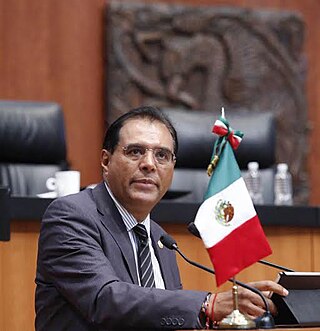Related Research Articles

The third federal electoral district of Yucatán is one of the 300 electoral districts into which Mexico is divided for elections to the federal Chamber of Deputies and one of six such districts in the state of Yucatán.

The second federal electoral district of Coahuila is one of the 300 electoral districts into which Mexico is divided for elections to the federal Chamber of Deputies and one of eight such districts in the state of Coahuila.

The fifth federal electoral district of Coahuila is one of the 300 electoral districts into which Mexico is divided for elections to the federal Chamber of Deputies and one of eight such districts in the state of Coahuila.

The twelfth federal electoral district of Mexico City is one of the 300 electoral districts into which Mexico is divided for elections to the federal Chamber of Deputies and one of the 22 currently operational districts in Mexico City.

The fourteenth federal electoral district of Mexico City is one of the 300 electoral districts into which Mexico is divided for elections to the federal Chamber of Deputies and one of the 22 currently operational districts in Mexico City.

Mario Martín Delgado Carrillo is a Mexican politician affiliated with the National Regeneration Movement (MORENA). Delgado Carrillo has served as the Secretary of Public Education in the cabinet of President Claudia Sheinbaum since 1 October 2024. From 5 November 2020 to 30 September 2024 he was the party's president.

Socorro Sofío Ramírez Hernández is a Mexican politician. Born in Tlalixtaquilla, Guerrero, he has at different times been affiliated with both the Institutional Revolutionary Party (PRI) and the Party of the Democratic Revolution (PRD).

Ángel Benjamín Robles Montoya is a Mexican politician affiliated with the Labor Party (PT) who previously belonged to both the Party of the Democratic Revolution (PRD) and Convergencia.
Carol Antonio Altamirano is a Mexican politician and lawyer. He was previously affiliated with the Party of the Democratic Revolution (PRD) but has since aligned with the National Regeneration Movement (Morena).

Antonio García Conejo is a Mexican politician affiliated with the Party of the Democratic Revolution (PRD).
María del Rosario Merlín García is a Mexican politician. Formerly affiliated with the Party of the Democratic Revolution (PRD), she later shifted allegiance to the National Regeneration Movement (Morena).

Raúl Paz Alonzo is a Mexican politician affiliated with the National Regeneration Movement (Morena) who previously belonged to the National Action Party (PAN).

Gerardo Villanueva Albarrán is a Mexican politician affiliated with the National Regeneration Movement who formerly belonged to both the Citizens' Movement (MC) and the Party of the Democratic Revolution (PRD).
Ana Lilia Guillén Quiroz is a Mexican politician affiliated with the Party of the Democratic Revolution (PRD) and, later, with the National Regeneration Movement (Morena).
Gerardo Ulloa Pérez is a Mexican politician. At different times he has been affiliated with the Party of the Democratic Revolution (PRD) and with the National Regeneration Movement (Morena).
Carlos Sánchez Barrios is a Mexican politician affiliated with the National Regeneration Movement (Morena) who previously belonged to the Party of the Democratic Revolution (PRD).

Juan Hugo de la Rosa García is a Mexican politician. He has been affiliated with both the Party of the Democratic Revolution (PRD) and the National Regeneration Movement (Morena).

The first federal electoral district of Durango is one of the 300 electoral districts into which Mexico is divided for elections to the federal Chamber of Deputies and one of four such districts currently operating in the state of Durango.

The fifth federal electoral district of Guerrero is one of the 300 electoral districts into which Mexico is divided for elections to the federal Chamber of Deputies and one of eight such districts in the state of Guerrero.
Araceli Saucedo Reyes is a Mexican politician who has served in both chambers of Congress. Previously affiliated with the Party of the Democratic Revolution (PRD), she joined the ranks of the National Regeneration Movement (Morena) in the Senate on 28 August 2024.
References
- 1 2 "Perfil: Dip. Javier Armando Manzano Salazar, LIX Legislatura". Sistema de Información Legislativa (SIL). SEGOB . Retrieved 9 August 2024.
- ↑ "Perfil: Dip. Javier Manzano Salazar, LXIV Legislatura". Sistema de Información Legislativa (SIL). SEGOB . Retrieved 9 August 2024.